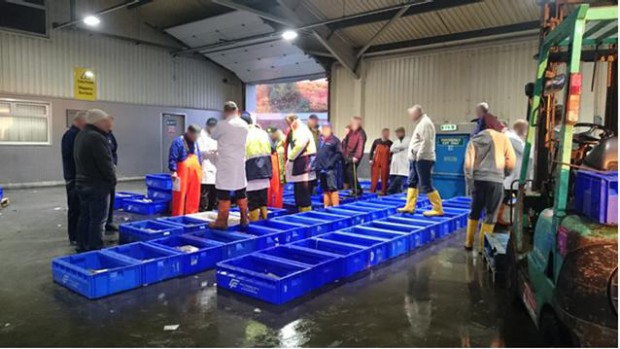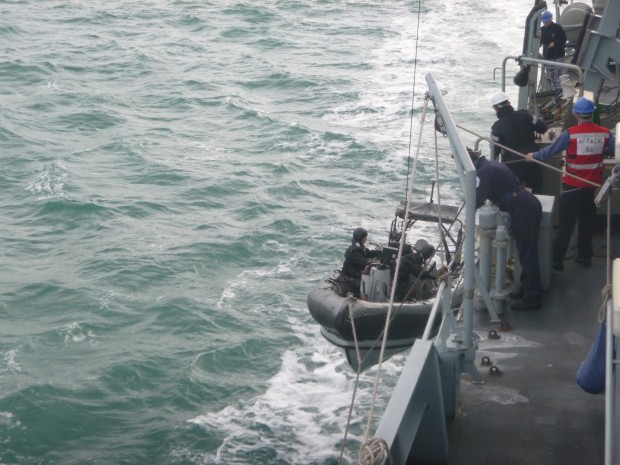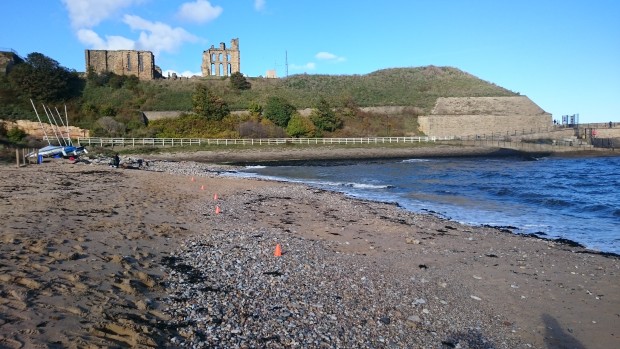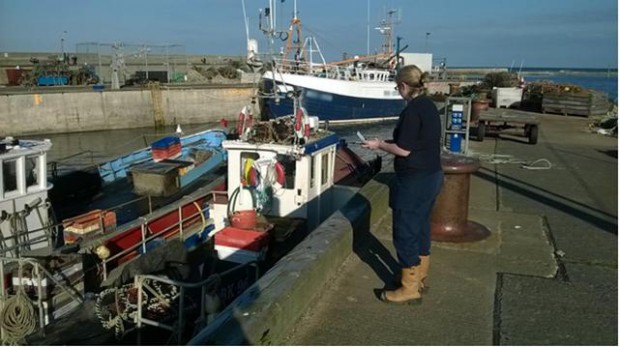Monday
Up early and I start the week with a 7:00am market inspection at North Shields Fish Auction Hall. I arrive to find fish being weighed and sorted into boxes by species ready for the auction at 7:30am.
I use this time to chat with the auction manager about local fishing activity and trends, fishing industry compliance with Marine Management Organisation’s (MMO) Day’s At Sea scheme and the much anticipated and imminent nephrop season which will attract visiting fishing vessels from all over Scotland and Northern Ireland to the area.
A colleague arrives to join me at 7:15am and we proceed to carry out some minimum size checks on cod, sole and whiting before observing the local merchants bid for their fish of the day!

Back at the office and it’s time to plan for the week ahead. At the weekly team meeting we discuss the current fishing activity, industry compliance and marine licences in our area and decide where to carry out our risk based inspections.
Monday afternoon is dedicated to interviewing a fisherman who was boarded previously by the Royal Navy and found to be fishing with illegal nets, a criminal offence. As lead interviewer I have created an interview plan and exhibits which I intend to show the suspect. As a criminal investigation, the interview is carried out in private and is conducted under formal caution in line with the Police and Criminal Evidence Act (1984).
I have a colleague with me whose role is to make notes of what has been said during the interview, although it is also recorded onto disc with a copy given to the suspect before he leaves. Once the interview has concluded I complete the relevant legal paperwork whilst things are still fresh in my mind and then call it a day.
Tuesday
HMS Mersey is in the area and a colleague and I have been invited to spend a day at sea with the Royal Navy discussing fisheries patrols carried out by the Navy and receiving a guided tour of the vessel. We board via a gangplank at Royal Quays, North Shields and head out of the mouth of the Tyne a short time later.
We start off with a tour of the vessel including the decks, gymnasium, ending on the bridge where we discuss the role of the Royal Navy in fisheries protection. A team of Royal Navy officers are preparing to disembark the mother ship in a Rigid-Hulled Inflatable Boat (RHIB) and are receiving instructions from MMO Operations room and the HMS Mersey Commanding Officer. We observe the boarding party board a fishing vessel a short distance away and listen to radio contact throughout the inspection. No offences are found and the team return to the mother ship.

After lunch the boarding party set off again, this time with my colleague and I in tow so that we can observe them at close range whilst their inspection is carried out. Halfway through the inspection it is clear that there is an issue with one of the nets on board and further advice is sought from the MMO Operations room. By now it is late in the afternoon and darkness has fallen so the decision is made by HMS Mersey’s Commanding Officer to return myself and my colleague to shore whilst the boarding party remain with the fishing vessel until the inspection is complete.
The wind is icy cold and has whipped the tide up by now and we disembark back into the RHIB with strict instructions to hold on tight. The exhilarating journey back takes us around 25 minutes and it is a relief to reach dry land. I’m definitely ready for a warm drink and a soothing hot bath!
Wednesday
After the excitement of yesterday it’s a quiet day in the office for me and a chance for me to catch up on some paperwork and other duties. I spend a couple of hours in the morning completing the prosecution file in relation to the interview on Monday so that MMO’s Senior Officers can make a decision on what action should be taken.
Mid-morning I attend a dial in meeting with colleagues from the Marine Conservation and Enforcement Team (MCET) to discuss proposed management measures for the offshore Marine Conservation Zones (MCZ) in the North Sea covered by the MMO Northern Marine Area. There are various proposals to manage the sites to prevent damage to the protected features and we discuss the pros and cons of each as well as the cost and resource implications. We agree on which proposals are the ones to take forward and leave this with MCET to progress with the Department for Environment, Food and Rural Affairs (Defra).
I spend the first part of the afternoon responding to a marine licence consultation request from the MMO’s marine consents team who have received an application from a local authority who are requesting to replace a local outfall pipe on a beach. I read through the proposed methodology and provide a response to the consents team which takes into account any impacts to the fishing industry, protected areas (e.g. Site of Special Scientific Interest Marine Protected Areas etc.), marine wildlife, pollution and impacts to other marine users. With collective responses from other consultees the consents team can then make an informed decision as to whether to issue a licence for the work and what licence conditions to impose.
The second part of the afternoon is spent on a local beach with a colleague from the MMO Eastern Marine Area undergoing training into the use of Global Positioning System equipment owned by MMO. This equipment allows us to accurately measure the Mean High Water Springs (MHWS) mark in tidal locations against chart datum. This can help when unlicensed marine works are suspected and there are disputes as to whether the work was carried out above MHWS or below (MMO regulate marine works below the MHWS).
We spend around an hour measuring the MHWS mark at Little Haven Beach in Tynemouth and return to the office to plot this onto a map. Training complete, I am in a much better position to use the equipment unaided if required.

Thursday
I start the day with some joint working with the Northumberland Inshore Fisheries Conservation Authority (IFCA) where we visited a local restaurant following intelligence that undersized shellfish was being offered for sale – an offence under Council Regulation 850/98. We arrive on site and are greeted by the head chef who gives us access to the kitchen, refrigerators and freezers so that we can inspect and measure the shellfish on the premises.
We locate 2 boxes of lobsters and measure and record their sizes as being in excess of the minimum landing size. No offences have been committed and we leave a short while later after educating the chef and landlord on the rules surrounding the landing, transportation, purchase and sale of shellfish.
The next task is a visit to Holy Island to inspect some improvement works to the harbour that have been funded by the European Fisheries Fund (EFF). As the improvement works also required a marine licence for work being carried out below MHWS I also inspect the licence for this to ensure the licence conditions have been met.
On site I meet with the foreman of the pier heightening works and the project manager of EFF application and I am given a tour of the improvements. We discuss how the improvements will benefit the local fishing industry by allowing them to land catches at the pier during high tide which previously covered the pier making landing impossible and restricting the times they could fish. I am content that my inspection concludes that the works were carried out compliantly and I retreat to the mainland before the tide prevents me from crossing the causeway!
It’s on to Seahouses where we grab a bite of lunch before proceeding to the harbour to carry out some landing inspections on fishing vessels returning to the harbour with their catch. The first boat arrives with a very happy crew who are pleased with their bumper haul of crabs and lobsters today. They welcome us on board where we carry out some minimum size checks and make a note of the weights of species being landed. This will then be cross referenced with any sales notes submitted to MMO from merchants purchasing this catch to ensure we are receiving accurate figures.
Inspection complete, I record the details in my official notebook and move onto the next vessel which has almost finished landing his catch into the back of a refrigerated lorry. I take this opportunity to carry out a transport check – this allows us to monitor which species and weights are being transferred from the vessel and to which merchant so that it can be cross referenced back at the office. This assists MMO with meeting its EU fishery reporting targets.

Friday
A colleague and I have arranged to charter the Northumberland IFCA fisheries patrol vessel and spend a day carrying out some joint at sea enforcement. It’s a perfect weather day and the sea is flat calm which makes our job boarding fishing vessels at sea that whole lot easier! It takes us around three hours to steam out to the fishing grounds outside the 12 nautical mile limit where we locate two local scalloping vessels and make the decision to carry out boarding inspections.
The RHIB is released from the NIFCA patrol vessel (with myself, my boarding colleague, two IFCA Officer’s and all of our kit on board) and we head for the first boat. We pull alongside the Port side and the two crew on board provide safe boarding ladders on the side of the vessel. My colleague climbs aboard and I pass up our enforcement equipment before climbing on board myself.
We begin our inspection by carrying out a paperwork check in the wheelhouse, ensuring that the vessel is licensed to fish and all legislative documents are in order. We then ask the skipper to haul his fishing gear so that we can carry out an inspection of the scallop dredges to check that they are in line with regulations. The next job is to crawl into the fish room so that we can carry out some minimum size checks of the scallops that are already packaged on board. My colleague carries out the measuring whilst I record the results.

All checks complete and with no compliance issues we bid the happy crew farewell and disembark ready for our next inspection. There are no other boats on the horizon once we have completed the two inspections, so we head back to the Northumberland IFCA patrol vessel to begin the journey back to port with the intention of attempting to board any trawling vessel we come across on the journey. Back on dry land it takes me a little while to adjust to my land legs and after a week of hard work I head home for a well earned beer!
3 comments
Comment by Cllr Clare Head posted on
Fascinating glimpse into your very necessary work.
Cllr Clare Head
London Borough of Richmond upon Thames
Comment by carlharvey posted on
Thank you for your comment Clare.
Comment by Hazel rutherford posted on
What a busy little bee. It sounds as though you love your job. Wish I could come with you. XXX